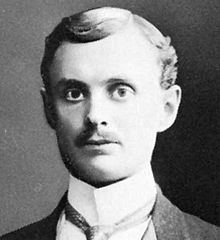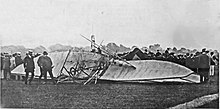Charles Rolls
Charles Rolls | |
|---|---|
 | |
| Born | 27 August 1877 |
| Died | 12 July 1910 (aged 32) |
| Nationality | United Kingdom |
| Occupation | Engineer |
| Engineering career | |
| Projects | Rolls-Royce |
| Signature | |
Charles Stewart Rolls (27 August 1877 - 12 July 1910) was a motoring and aviation pioneer. Together with Frederick Henry Royce he co-founded the Rolls-Royce car manufacturing firm. He was the first Briton to be killed in a flying accident, when the tail of his Wright Flyer broke off during a flying display near Bournemouth, England. He was aged 32.
Early life
Rolls was born in Berkeley Square, London, third son of the 1st Baron Llangattock and Lady Llangattock. Despite his London birth, he retained a strong family connection with his ancestral home[1] of The Hendre, near Monmouth, Wales. After attending Mortimer Vicarage Preparatory School in Berkshire, he was educated at Eton College where his developing interest in engines earned him the nickname dirty Rolls.[2]
In 1894 he attended a private crammer in Cambridge which helped him gain entry to Trinity College, Cambridge where he studied mechanical and applied science. In 1896, at the age of 18, he travelled to Paris to buy his first car, a Peugeot Phaeton, and joined the Automobile Club of France. His Peugeot is believed to have been the first car based in Cambridge, and one of the first three cars owned in Wales. An early motoring enthusiast, he joined the Self-Propelled Traffic Association which campaigned against the restrictions imposed on motor vehicles by the Locomotive Act, and became a founder member of the Automobile Club of Great Britain with which it merged 1897.[3]
Rolls graduated from Cambridge University - where he won a Half Blue at cycling[4] - in 1898,[5] and began working on the steam yacht Santa Maria followed by a position at the London and North Western Railway in Crewe.[2] However, his talents lay more in salesmanship and motoring pioneering than practical engineering; in January 1903, with the help of £6,600 provided by his father, he started one of Britain's first car dealerships,[6] C.S.Rolls & Co. based in Fulham, to import and sell French Peugeot and Belgian Minerva vehicles.
Rolls was a tall man, standing at about 1.95 m (6'5").
Partnership with Royce

Rolls was introduced to Henry Royce by a friend at the Automobile Club, Henry Edmunds, who was also a director of Royce Ltd. Edmunds showed him Royce's car and arranged the historic meeting between Rolls and Royce at the Midland Hotel, Manchester, on 4 May 1904. In spite of his preference for three or four cylinder cars, Rolls was impressed with the two-cylinder Royce 10 and in a subsequent agreement of 23 December 1904 agreed to take all the cars Royce could make. These would be of two, three, four and six cylinders and would be badged as Rolls-Royces.

The first Rolls-Royce car, the Rolls-Royce 10 hp, was unveiled at the Paris Salon in December 1904, although in the early advertising it was the name of Rolls that was emphasised over that of Royce. In 1906 Rolls and Royce formalised their partnership by creating Rolls-Royce Limited, with Rolls appointed Technical Managing Director on a salary of £750 per annum plus 4% of the profits in excess of £10,000. Rolls provided the financial backing and business acumen to complement Royce's technical expertise. In 1907 Rolls-Royce Limited bought out C.S. Rolls & Co.
Rolls put much effort into publicising the quietness and smoothness of the Rolls-Royce, and at the end of 1906 travelled to the USA to promote the new cars. The company was winning awards for the quality and reliability of its cars by 1907. But by 1909 Rolls' interest in the business was waning, and at the end of the year he resigned as Technical Managing Director and became a non-executive director.[2]
Pioneer aviator

Rolls was also a pioneer aviator and initially, balloonist,[6] making over 170 balloon ascents. He was a founding member of the Royal Aero Club in 1903 and was the second person in Britain to be licensed to fly by it.[7] In 1903 he also won the Gordon Bennett Gold Medal for the longest single flight time.
By 1907 Rolls' interest turned increasingly to flying, and he tried unsuccessfully to persuade Royce to design an aero engine. In 1909 he bought one of six Wright Flyer aircraft built by Short Brothers under licence from the Wright Brothers, and made more than 200 flights. On 2 June 1910, he became the first man to make a non-stop double crossing of the English Channel by plane,[6] taking 95 minutes – faster than Blériot. For this feat, which included the first East-bound aerial crossing of the English Channel, he was awarded the Gold Medal of the Royal Aero Club.[8] There is a statue to commemorate the flight in Monmouth and another in Dover.
Death

On 12 July 1910, at the age of 32, Rolls was killed in an air crash at Hengistbury Airfield [9] Bournemouth when the tail of his Wright Flyer broke off during a flying display. He was the first Briton to be killed in an aeronautical accident with a powered aircraft, and the eleventh internationally. A statue in his memory, in which he is seen holding a biplane model, was erected in Agincourt Square, Monmouth. A further memorial to him is situated in the bottom playing field of St Peter's School, which was built on the site of Hengistbury Airfield.
His grave lies at the Monmouthshire church of Llangattock-Vibon-Avel, where many of the Rolls family lie buried in various family tombs. His grave is just below Llangattock Manor and bears the inscription:
Blessed are the pure in heart for they shall see God
-
Statue of Charles Rolls in Dover.
-
Rolls Family graves, Llangattock-Vibon-Avel, Monmouthshire.
-
Charles Rolls (centre), 1910.
Family tree
| John Rolls (1735–1801) | Sarah (d. 1801) | ||||||||||||||||||||||||||||||||
| John Rolls of the Hendre (1776–1837) | Martha | ||||||||||||||||||||||||||||||||
| John Etherington Welch Rolls (1807–70) | Elizabeth Mary Long | ||||||||||||||||||||||||||||||||
| John Allan Rolls (1837–1912) | Georgiana Marcia Maclean (1837 – 1923) | ||||||||||||||||||||||||||||||||
| John Maclean Rolls (1870–1916) | Henry Alan Rolls (1871–1916) | Eleanor Georgiana Rolls (1872–1961) | Charles Stewart Rolls (1877–1910) (co-founder of Rolls Royce) | ||||||||||||||||||||||||||||||
References
- ^ "The Hendre". Geograph Britain and Ireland. Retrieved 2011-06-29.
- ^ a b c Pugh, Peter (2001). The Magic of a Name - The Rolls-Royce Story: The First 40 Years. Icon Books. ISBN 1-84046-151-9.
- ^ Vance, James (1992). Ways of the World: A History of the World's Roads and of the Vehicles That Used Them. Rutgers University Press. ISBN 0-8135-2691-4.
- ^ The Bicycle, 15 July 1942, pG. Rolls won a half-blue because cycling was not considered a full sport. Rolls also had a collection of bicycles from solos up to four-man tandems.
- ^ "Rolls, the Hon. Charles Stewart (RLS895CS)". A Cambridge Alumni Database. University of Cambridge.
- ^ a b c "Charles Rolls". BBC. Retrieved 2011-06-29.
{{cite web}}: Italic or bold markup not allowed in:|publisher=(help) - ^ "The Royal Aero Club of the United Kingdom - Official Notices to Members" (PDF). Flight: 185. 1910. Retrieved 2011-06-29.
{{cite journal}}: Unknown parameter|month=ignored (help) - March 12, 1910 - ^ "Royal Aero Club Awards & Trophies". The Royal Aero Club of the United Kingdom. Retrieved 2011-06-29.
- ^ "Hengistbury Head In the 20th Century". Hengistbury Head. Retrieved 2011-06-29.
External links
 Works by or about Charles Stewart Rolls at Wikisource
Works by or about Charles Stewart Rolls at Wikisource- "Charles Rolls of Monmouthshire, co-founder of the world famous Rolls-Royce company". Famous Welsh. Retrieved 2011-06-29. - More about Charles Rolls
- "Charles Rolls". Early Birds of Aviation, Inc. Retrieved 2011-06-29. - Transcription of the report of his death in a contemporary newspaper
- "Search". Gathering the Jewels. Retrieved 2011-06-29. - Old Photo of Rolls and the Royal Family
- "Untitled Document". U.S. Centennial of Flight. NASA. Retrieved 2011-06-29. - Charles Rolls goes on his first aeroplane flight with Wilbur Wright on October 8, 1908 at Camp D'Auvours, France
- 1877 births
- 1910 deaths
- People from Westminster
- Alumni of Trinity College, Cambridge
- Old Etonians
- British aviators
- People from Monmouthshire
- British businesspeople
- Aviators killed in aviation accidents or incidents in the United Kingdom
- Rolls-Royce people
- British automobile designers
- British founders of automobile manufacturers
- Accidental deaths in England
- Younger sons of barons
- Members of the Early Birds of Aviation
- English people of Welsh descent
- Automotive pioneers
- Burials in Wales
- Monmouth, Wales
- English cyclists




